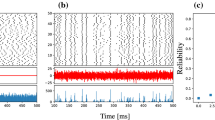Abstract
Usually neuronal responses to short-lasting stimuli are displayed as peri-stimulus time histogram. The function estimated by such a histogram allows to obtain informations about stimulus-induced postsynaptic events as long as the interpretation is restricted to the first response component after the stimulus. The interpretation of secondary response components is much more difficult, as they may be either due to stimulus effects or represent an “echo” of the primary response. In the present paper two output functions are developed that do not show such an echoing of responses. The first one, the interspike interval change function, represents an ideal way to quantify a neuronal stimulus response as its amplitude was found to be almost independent of the stimulation strategy used during acquisition of the spike train data. The other function, the displaced impulses function, allows to verify the statistical significance of an observed response component. Both functions may be estimated from stimulus-correlated spike train data, even if the neuron under investigation shows considerable interspike-interval variability in the absence of stimulation. The concepts underlying these neuronal output functions are developed on simulated responses of a Hodgkin-Huxley-type model for a mammalian neuron at body temperature that is exposed to a transient excitatory conductance increase. Additionally, estimation of these output functions is also demonstrated on responses of human soleus motoneurons that were exposed to electrical stimuli of the tibial nerve in the popliteal fossa.
Similar content being viewed by others
References
Abeles M (1982) Quantification, smoothing, and confidence limits for single units' histograms. J Neurosci Methods 5:317–325
Adams PR, Galvan M (1986) Voltage-dependent currents of vertebrate neurons and their role in membrane excitability. Adv Neurol 44:137–170
Andreassen S, Rosenfalck A (1980) Regulation of the firing pattern of single motor units. J Neurol Neurosurg Psychiatry 43:897–906
Ashby P, Zilm D (1982) Relationship between EPSP shape and cross-correlation profile explored by computer simulation for studies on human motoneurons. Exp Brain Res 47:33–40
Awiszus F (1988) Continuous functions determined by spike trains of a neuron subject to stimulation. Biol Cybern 58:321–327
Awiszus F (1989) On the description of neuronal output properties using spike train data. Biol Cybern 60:323–333
Awiszus F (1992a). The relationship between a neuronal cross-correlogram and the underlying postsynaptic current. Biol Cybern 67:279–283
Awiszus F (1992b). Reduction of a Hodgkin-Huxley-type model for a mammalian neuron at body temperature. Biol Cybern 67:427–432
Awiszus F, Feistner H, Schäfer SS (1991) On a method to detect long-latency excitations and inhibitions of single hand muscle motoneurons in man. Exp Brain Res 86:440–446
Blatz AL, Magleby KL (1986) Single apamin-blocked Ca-activated K+ channels of small conductance in cultured rat skeletal muscle. Nature 323:718–720
Blatz AL, Magleby KL (1987) Calcium-activated potassium channels. Trends Neurosci 10:463–467
Cobbett P, Legendre P, Mason WT (1989) Characterization of three types of potassium current in cultured neurones of rat supraoptic nucleus area. J Physiol (London) 410:443–462
Davey NJ, Ellaway PH, Stein RB (1986) Statistical limits for detecting change in the cumulative sum derivative of the peristimulus time histogram. J Neurosci Methods 17:153–166
Dengler R, Wolf W, Schubert M, Struppler A (1986) Discharge pattern of single motor units in basal ganglia disorder. Neurology 36:1061–1066
Ellaway PH (1978) Cumulative sum technique and its application to the analysis of peristimulus time histograms. Electroencephalogr Clin Neurophysiol 45:302–304
Freund H-J (1983) Motor unit and muscle activity in voluntary motor control. Physiol Rev 63:387–436
Gerstein GL, Kiang NY-S (1960) An approach to the quantitative analysis of electrophysiological data from single neurons. Biophys J 1:15–28
Jack JJB, Noble D, Tsien RW (1975) Electric current flow in excitable cells. Oxford University Press, New York
Kirkwood PA (1979) On the use and interpretation of cross-correlation measurements in the mammalian central nervous system. J Neurosci Methods 1:107–132
Knox CK, Poppele RE (1977) Correlation analysis of stimulusevoked changes in excitability of spontaneously firing neurons. J Neurophysiol 40:616–625
Marmarelis PZ, Marmarelis VZ (1978) Analysis of physiological systems: The white-noise approach. Plenum Press, New York
Mises R von (1964) Mathematical theory of probability and statistics. Academic Press, New York
Moore GP, Perkel DH, Segundo JP (1966) Statistical analysis and functional interpretation of neuronal spike data. Annu Rev Physiol 28:493–522
Perkel DH, Gerstein GL, Moore GP (1967) Neuronal spike trains and stochastic point processes. I. The single spike train. Biophys J 7:391–418
Press WH, Flannery BP, Teukolsky SA, Vetterling WT (1986) Numerical recipes: the art of scientific computing. Cambridge University Press, Cambridge
Prochazka VJ, Conrad B, Sindermann F (1973) Computerized singleunit interval analysis and its clinical application. In: Desmedt JE (eds) New developments in electromyography and clinical neurophysiology, vol 2. Karger, Basel, pp 462–468
Schwarz JR, Eikhof G (1987) Na currents and action potentials in rat myelinated nerve fibers at 20 and 37°C. Pflügers Arch 409:569–577
Tuckwell HC (1988) Introduction to theoretical neurobiology: volume 2 nonlinear and stochastic theories. Cambridge University Press, Cambridge
Author information
Authors and Affiliations
Rights and permissions
About this article
Cite this article
Awiszus, F. Quantification and statistical verification of neuronal stimulus responses from noisy spike train data. Biol. Cybern. 68, 267–274 (1993). https://doi.org/10.1007/BF00224862
Received:
Accepted:
Issue Date:
DOI: https://doi.org/10.1007/BF00224862




